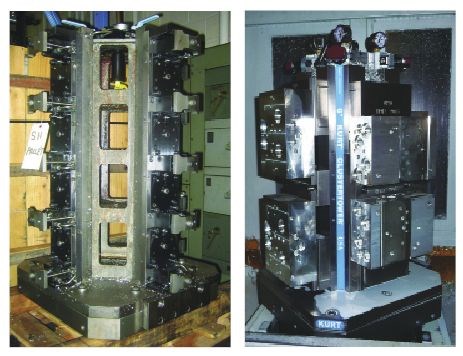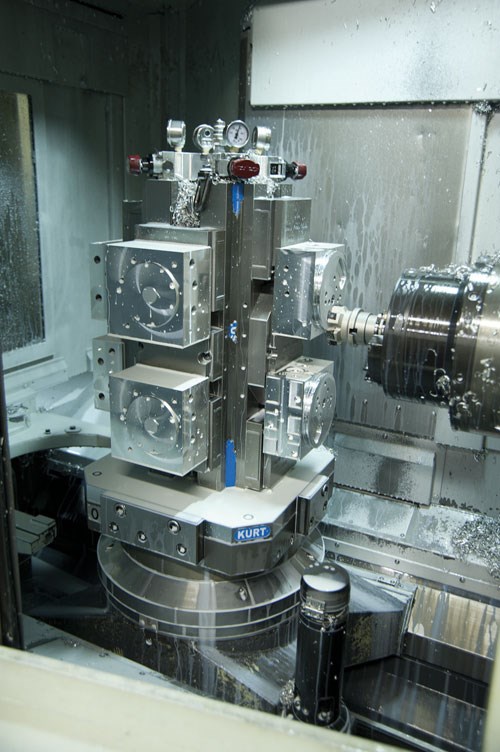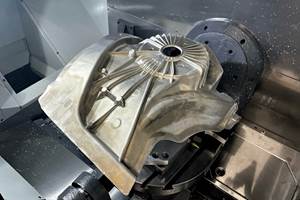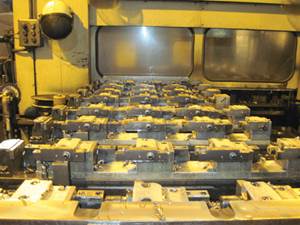Successfully expanding a product line can involve more than just increasing part volumes—in some instances, it requires rethinking critical aspects of the production process. Such was the case when Western Products broadened its offering of snow-removal equipment, a move that revealed the shortcomings of a workholding method that had been in place for more than 15 years. Replacing dedicated fixtures with standard, hydraulic ClusterTower vertical vises and quick-change jaws from Kurt Manufacturing Co. (Minneapolis, Minnesota) has enabled one machine to do the work of two. The system has also reduced setup time and improved accuracy, productivity and feature-to-feature concentricity, all without compromising rigidity. Scrap, while never a significant concern, has been reduced by half.
For more than 60 years, Western Products has specialized in manufacturing contractor-grade snowplows for commercial, institutional and municipal customers as well as homeowners. It offers more than a dozen models, all of which are powered by hydraulics. The company says designing and building hydraulic systems in-house provides a major competitive advantage.
Nonetheless, that work involves its own set of challenges. Among the most critical machined parts are primary and secondary manifolds that regulate the constantly changing hydraulic pressures. These components are constructed of 6061 aluminum, a heavy-duty, corrosion-resistant material, to help withstand the demands of higher pressures. However, ensuring the manifolds operate efficiently through many cycles without leaking requires not just the right material, but also machining within tight tolerances, the company reports. Port configurations and other features vary by model, but all manifolds require face milling, drilling, tapping, thread milling and hydraulic porting operations. Historically, Western Products has conducted this work on two, twin-pallet Mori Seiki NH-400 HMCs.
As the company began to expand its offering of snowplows, management remained satisfied with the performance of these machines. However, they soon became concerned about a growing bottleneck at the setup stage. The shop used dedicated hydraulic tombstones with swing clamps to grip the manifolds on the machines, and different part sizes required different fixtures. While this system had served adequately for approximately 15 years, it started to falter amid the increased variety and quantity of manifolds.
“We were increasing the number of machining setups and adding too much manifold work-in-process,” says Brian Thoreson, machine shop supervisor. “We decided to see if there was a more efficient workholding process available to improve quality while allowing us to continue using our existing machining centers.”
The search for a solution led to consultations with Michael Dulmes, a sales representative at Kurt Workholding who introduced the shop to the ClusterTower vertical vises. The setup he proposed would incorporate two sets of custom jaws, one to grip the extruded workpiece blanks for the first set of machining operations, and one to grip the reverse sides of the parts for additional machining. On paper, this promised to make change-overs faster and easier.
In practice, the new setup has worked exactly as planned, Mr. Thoreson says. The time required to actually load and unload parts hasn’t changed, but unlike the dedicated fixtures, the ClusterTowers stay on the table. Before, the operator had to replace the entire setup to change from one manifold model to another, a process that took 30 minutes and required using a hoist. “Now, to change setups, we just unsnap the jaws, adjust the vise opening for the new part by hand, and we’re ready to pressurize and run new parts,” he says.
Additionally, operators can use features machined in the first set of machining operations to position workpieces in the second set of custom jaws. In contrast, the previous system of dedicated fixtures required milling holding slots into each part. The new setup also enables machining two different manifold models on the same machine. “We do this on two 8-hour shifts, something we weren’t able to do before,” Mr. Thoreson says. “We machine approximately 480 manifolds most weeks, 240 of each size. Even with these quantities, we are able to eliminate the use of the second machine and free it up for other work.”
The system’s benefits extend beyond just reduced setup time. Previously, accommodating a new manifold design or an engineering change to an existing design required a new dedicated fixture costing thousands of dollars. Now, all that’s required is a new set of jaws that costs only a few hundred dollars. Mr. Thoreson adds that the turnaround time to obtain new jaws from Kurt is measured in days, whereas building a new dedicated fixture could take weeks.
Mr. Thoreson reports that he and his team initially were skeptical that a standard workholding setup would provide the required locating accuracy and rigidity. However, clamping pressure ranging from 3,000 to 3,100 psi has proven more than sufficient to keep parts stable and to damp cutter-induced vibration. In fact, he reports that the shop can achieve part-to-part repeatability of 0.0005 inch, even at a top spindle speed of 15,000 rpm and feed rates ranging to 350 ipm. According to Kurt, machining the ClusterTowers from 80,000-psi ductile iron contributes to the system’s rigidity. “We run as aggressively as possible with the highest feed rates because the Kurt ClusterTowers can take it,” Mr. Thoreson says.

















.png;maxWidth=300;quality=90)









